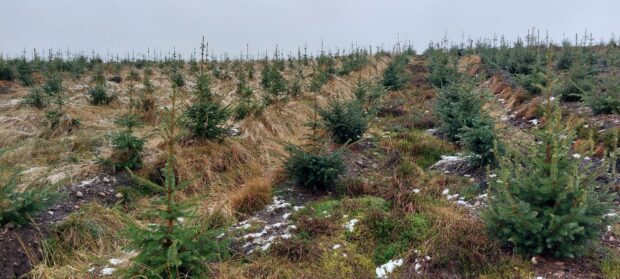Neil Crookston, regional manager (north) at Scottish Woodlands, discusses the vital role of timber production in growing a sustainable future.
-
Some Press and Journal online content is funded by outside parties. The revenue from this helps to sustain our independent news gathering. You will always know if you are reading paid-for material as it will be clearly labelled as “Partnership” on the site and on social media channels.
This can take two different forms.
“Presented by”
This means the content has been paid for and produced by the named advertiser.
“In partnership with”
This means the content has been paid for and approved by the named advertiser but written and edited by our own commercial content team.
Our climate emergency has been publicised widely and the importance of reducing our carbon emissions and increasing carbon sequestration is well known. Forestry and timber production have a vital part to play in this emergency.
Carbon sequestration in forestry
The science behind carbon sequestration in forestry is well established and the basics are simple biology. Trees absorb carbon dioxide and store carbon. Trees are a vital carbon sink and have a big part to play to increasing the sequestration of carbon dioxide as we look to tackle our climate emergency.
Last week it was reported that carbon emissions in the Amazon region more than doubled in 2019/20 compared to the past 8-year average. This was linked to deforestation caused by logging, land use change and fire, encouraged by poor law enforcement in the area.
In some parts this deforestation has resulted in more carbon being emitted than being absorbed. Given our climate emergency this is a worrying situation in one of the world’s largest forests.
Trees grown for timber production enable the sequestered carbon to be stored in the timber products themselves. A renewable resource in well managed forests, following harvesting woodland is replanted and the cycle repeats, allowing more carbon to be embodied in future timber products.
These products can substitute more energy and carbon intensive building materials such as concrete and steel.
Sustaining global timber supplies
Plantation woodland produces more than one third of the world’s industrial timber despite making up less than 5% of the total forest area.
This demonstrates the importance plantations play in sustaining timber supplies in a global market where demand for wood products is growing.
We can focus timber production on smaller areas to increase productivity whilst reducing our reliance on natural forests at great environmental cost.
Unsurprisingly China is the world’s biggest importer of wood products, however the United Kingdom is the second biggest importer of wood products, importing 82% of wood requirements.
Whilst we will never remove our reliance on imported timber, increasing our domestic market through establishing more plantations will help reduce the dependence on imports and to provide some greater timber security. It may also help to address the issue of global deforestation.
Responsible and sustainable forest management
We have a well-regulated forest industry in the UK, guided by The UK Forestry Standard. This standard guides our approach to sustainable forest management. It outlines how we manage our woodlands to protect and enhance our environment along with managing the economic timber resource.
In addition, many of the UK’s productive woodlands are independently certified to demonstrate responsible management through schemes such as FSC. UK grown timber is a sustainable well managed resource.
Grants for woodland creation
Currently Scotland has just under 19% of land as forest cover (the UK has 12% forest cover). The Scottish Government has a target to increase this to 21% by 2032 as part of its plans tackling climate change.
To help increase woodland cover in Scotland there is grant support available through Scotland’s Forestry Grant Scheme. This scheme provides opportunities for various new woodland creation models from commercial conifers to native broadleaves.
Landowners can also benefit from trading carbon units, with The UK Woodland Carbon Code providing the government standard for verification, including third party verification.
It is important that these schemes facilitate all types of new woodland creation, including productive plantations. Here in the UK these plantations provide a sustainable, well-regulated timber resource.
This is vital for our future timber security, a strong rural economy and increasing carbon sequestration and storage.
The key principle guides us – the right tree, in the right place, for the right reason.
Find out more about the work of Scottish Woodlands and the importance of timber production.
